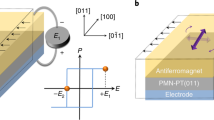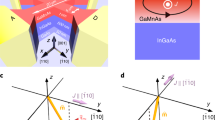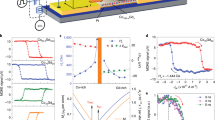Abstract
Magnetization switching at the interface between ferromagnetic and paramagnetic metals, controlled by current-induced torques, could be exploited in magnetic memory technologies. Compelling questions arise regarding the role played in the switching by the spin Hall effect in the paramagnet and by the spin–orbit torque originating from the broken inversion symmetry at the interface. Of particular importance are the antidamping components of these current-induced torques acting against the equilibrium-restoring Gilbert damping of the magnetization dynamics. Here, we report the observation of an antidamping spin–orbit torque that stems from the Berry curvature, in analogy to the origin of the intrinsic spin Hall effect. We chose the ferromagnetic semiconductor (Ga,Mn)As as a material system because its crystal inversion asymmetry allows us to measure bare ferromagnetic films, rather than ferromagnetic–paramagnetic heterostructures, eliminating by design any spin Hall effect contribution. We provide an intuitive picture of the Berry curvature origin of this antidamping spin–orbit torque as well as its microscopic modelling. We expect the Berry curvature spin–orbit torque to be of comparable strength to the spin-Hall-effect-driven antidamping torque in ferromagnets interfaced with paramagnets with strong intrinsic spin Hall effect.
This is a preview of subscription content, access via your institution
Access options
Subscribe to this journal
Receive 12 print issues and online access
$259.00 per year
only $21.58 per issue
Buy this article
- Purchase on Springer Link
- Instant access to full article PDF
Prices may be subject to local taxes which are calculated during checkout




Similar content being viewed by others
References
Miron, I. M. et al. Perpendicular switching of a single ferromagnetic layer induced by in-plane current injection. Nature 476, 189–193 (2011).
Liu, L. et al. Spin–torque switching with the giant spin Hall effect of tantalum. Science 336, 555–558 (2012).
Edelstein, V. M. Spin polarization of conduction electrons induced by electric current in two-dimensional asymmetric electron systems. Solid State Commun. 73, 233–235 (1990).
Bernevig, B. A. & Vafek, O. Piezo-magnetoelectric effects in p-doped semiconductors. Phys. Rev. B 72, 033203 (2005).
Manchon, A. & Zhang, S. Theory of nonequilibrium intrinsic spin torque in a single nanomagnet. Phys. Rev. B 78, 212405 (2008).
Manchon, A. & Zhang, S. Theory of spin torque due to spin–orbit coupling. Phys. Rev. B 79, 094422 (2009).
Matos-Abiague, A. & Rodriguez-Suarez, R. L. Spin–orbit coupling mediated spin torque in a single ferromagnetic layer. Phys. Rev. B 80, 094424 (2009).
Chernyshov, A. et al. Evidence for reversible control of magnetization in a ferromagnetic material by means of spin–orbit magnetic field. Nature Phys. 5, 656–659 (2009).
Garate, I. & MacDonald, A. H. Influence of a transport current on magnetic anisotropy in gyrotropic ferromagnets. Phys. Rev. B 80, 134403 (2010).
Endo, M., Matsukura, F. & Ohno, H. Current induced effective magnetic field and magnetization reversal in uniaxial anisotropy (Ga,Mn)As. Appl. Phys. Lett. 97, 222501 (2010).
Fang, D. et al. Spin–orbit driven ferromagnetic resonance: a nanoscale magnetic characterization technique. Nature Nanotech. 6, 413–417 (2011).
Miron, I. M. et al. Current-driven spin torque induced by the Rashba effect in a ferromagnetic metal layer. Nature Mater. 9, 230–234 (2010).
Pi, U. H. et al. Tilting of the spin orientation induced by Rashba effect in ferromagnetic metal layer. Appl. Phys. Lett. 97, 162507 (2010).
Hals, K. M. D., Brataas, A. & Tserkovnyak, Y. Scattering theory of charge-current-induced magnetization dynamics. Europhys. Lett. 90, 47002 (2010).
Miron, I. M. et al. Fast current-induced domain-wall motion controlled by the Rashba effect. Nature Mater. 10, 419–423 (2011).
Suzuki, T. et al. Current-induced effective field in perpendicularly magnetized Ta/CoFeB/MgO wire. Appl. Phys. Lett. 98, 142505 (2011).
Kim, K-W., Seo, S-M., Ryu, J., Lee, K-J. & Lee, H-W. Magnetization dynamics induced by in-plane currents in ultrathin magnetic nanostructures with Rashba spin–orbit coupling. Phys. Rev. B 85, 180404(R) (2012).
Pesin, D. A. & MacDonald, A. H. Quantum kinetic theory of current-induced torques in Rashba ferromagnets. Phys. Rev. B 86, 014416 (2012).
Wang, X. & Manchon, A. Diffusive spin dynamics in ferromagnetic thin films with a Rashba interaction. Phys. Rev. Lett. 108, 117201 (2012).
Haney, P. M., Lee, H-W., Lee, K-J., Manchon, A. & Stiles, M. D. Current induced torques and interfacial spin-orbit coupling: semiclassical modeling. Phys. Rev. B 87, 174411 (2013).
Van der Bijl, E. & Duine, R. A. Current-induced torques in textured Rashba ferromagnets. Phys. Rev. B 86, 094406 (2012).
Kim, J. et al. Layer thickness dependence of the current-induced effective field vector in Ta–CoFeB–MgO. Nature Mater. 12, 240–245 (2012).
Garello, K. et al. Symmetry and magnitude of spin–orbit torques in ferromagnetic heterostructures. Nature Nanotech. 8, 587–593 (2013).
Li, H., Wang, X., Dogan, F. & Manchon, A. Tailoring spin–orbit torque in diluted magnetic semiconductors. Appl. Phys. Lett. 102, 192411 (2013).
Liu, L., Lee, O. J., Gudmundsen, T. J., Ralph, D. C. & Buhrman, R. A. Current-induced switching of perpendicularly magnetized magnetic layers using spin torque from the spin Hall effect. Phys. Rev. Lett. 109, 096602 (2011).
Dyakonov, M. I. & Perel, V. I. Current-induced spin orientation of electrons in semiconductors. Phys. Lett. A 35, 459–460 (1971).
Hirsch, J. E. Spin Hall effect. Phys. Rev. Lett. 83, 1834–1837 (1999).
Murakami, S., Nagaosa, N. & Zhang, S-C. Dissipationless quantum spin current at room temperature. Science 301, 1348–1351 (2003).
Sinova, J. et al. Universal intrinsic spin Hall effect. Phys. Rev. Lett. 92, 126603 (2004).
Kato, Y. K., Myers, R. C., Gossard, A. C. & Awschalom, D. D. Observation of the spin Hall effect in semiconductors. Science 306, 1910–1913 (2004).
Wunderlich, J., Kaestner, B., Sinova, J. & Jungwirth, T. Experimental observation of the spin Hall effect in a two dimensional spin–orbit coupled semiconductor system. Phys. Rev. Lett. 94, 047204 (2005).
Jungwirth, T., Wunderlich, J. & Olejnik, K. Spin Hall effect devices. Nature Mater. 11, 382–390 (2012).
Slonczewski, J. C. Current-driven excitation of magnetic multilayers. J. Magn. Magn. Mater. 159, L1–L7 (1996).
Berger, L. Emission of spin waves by a magnetic multilayer traversed by a current. Phys. Rev. B 54, 9353–9358 (1996).
Ralph, D., Stiles, M. & Bader, S. Current perspectives: spin transfer torques. J. Magn. Magn. Mater. 320, 1189–1311 (2008).
Brataas, A., Kent, A. D. & Ohno, H. Current-induced torques in magnetic materials. Nature Mater. 11, 372–381 (2012).
Tanaka, T. et al. Intrinsic spin Hall effect and orbital Hall effect in 4d and 5d transition metals. Phys. Rev. B 77, 165117 (2008).
Engel, H-A., Rashba, E. I. & Halperin, B. I. Out-of-plane spin polarization from in-plane electric and magnetic fields. Phys. Rev. Lett. 98, 036602 (2007).
Jungwirth, T., Niu, Q. & MacDonald, A. H. Anomalous Hall effect in ferromagnetic semiconductors. Phys. Rev. Lett. 88, 207208 (2002).
Nagaosa, N., Sinova, J., Onoda, S., MacDonald, A. H. & Ong, N. P. Anomalous Hall effect. Rev. Mod. Phys. 82, 1539–1592 (2010).
Jungwirth, T., Sinova, J., Mašek, J., Kučera, J. & MacDonald, A. H. Theory of ferromagnetic (III,Mn)V semiconductors. Rev. Mod. Phys. 78, 809–864 (2006).
Tulapurkar, A. A. et al. Spin–torque diode effect in magnetic tunnel junctions. Nature 438, 339–342 (2005).
Nemec, P. et al. The essential role of carefully optimized synthesis for elucidating intrinsic material properties of (Ga,Mn)As. Nature Commun. 4, 1422 (2013).
Harder, M., Cao, Z. X., Gui, Y. S., Fan, X. L. & Hu, C. M. Analysis of the line shape of electrically detected ferromagnetic resonance. Phys. Rev. B 84, 054423 (2011).
Silver, M., Batty, W., Ghiti, A. & OReilly, E. P. Strain-induced valence-subband splitting in III-V semiconductors. Physica B 46, 6781–6788 (1992).
Stefanowicz, W. et al. Magnetic anisotropy of epitaxial (Ga,Mn)As on (113)A GaAs. Phys. Rev. B 81, 155203 (2010).
Vanhaverbeke, A. & Viret, M. Simple model of current-induced spin torque in domain walls. Phys. Rev. B 75, 024411 (2007).
Fernández-Rossier, J., Núñez, A. S., Abolfath, M. & MacDonald, A. H. Optical spin transfer in ferromagnetic semiconductors. Preprint at http://lanl.arXiv.org/cond-mat/0304492 (2003).
Nemec, P. et al. Experimental observation of the optical spin transfer torque. Nature Phys. 8, 411–415 (2012).
Acknowledgements
The authors acknowledge support from the EU European Research Council (ERC) advanced grant no. 268066, from the Ministry of Education of the Czech Republic grant no. LM2011026, from the Grant Agency of the Czech Republic grant no. 14-37427G, from the Academy of Sciences of the Czech Republic Praemium Academiae, and support from US grants ONR-N000141110780, NSF-DMR-1105512 and NSF TAMUS LSAMP BTD award 1026774. A.J.F. acknowledges support from a Hitachi research fellowship. H.K. acknowledges financial support from the Japan Science and Technology Agency (JST).
Author information
Authors and Affiliations
Contributions
Theory and data modelling were performed by T.J., E.K.V., L.P.Z., K.V. and J.S. Materials were prepared by V.N., R.P.C. and B.L.G. Sample preparation was performed by A.C.I. Experiments and data analysis were carried out by H.K., D.F., J.W. and A.J.F. The manuscript was written by T.J., A.J.F., H.K. and J.S., and project planning was performed by T.J., A.J.F., J.S. and H.K.
Corresponding author
Ethics declarations
Competing interests
The authors declare no competing financial interests.
Supplementary information
Supplementary information
Supplementary information (PDF 734 kb)
Rights and permissions
About this article
Cite this article
Kurebayashi, H., Sinova, J., Fang, D. et al. An antidamping spin–orbit torque originating from the Berry curvature. Nature Nanotech 9, 211–217 (2014). https://doi.org/10.1038/nnano.2014.15
Received:
Accepted:
Published:
Issue Date:
DOI: https://doi.org/10.1038/nnano.2014.15
This article is cited by
-
Room temperature energy-efficient spin-orbit torque switching in two-dimensional van der Waals Fe3GeTe2 induced by topological insulators
Nature Communications (2023)
-
Magnetism, symmetry and spin transport in van der Waals layered systems
Nature Reviews Physics (2022)
-
Large damping-like spin–orbit torque in a ferromagnet/topological insulator bilayer from localized interfacial states
Journal of the Korean Physical Society (2022)
-
Observation of the antiferromagnetic spin Hall effect
Nature Materials (2021)
-
Effective Hamiltonian for silicene under arbitrary strain from multi-orbital basis
Scientific Reports (2021)



